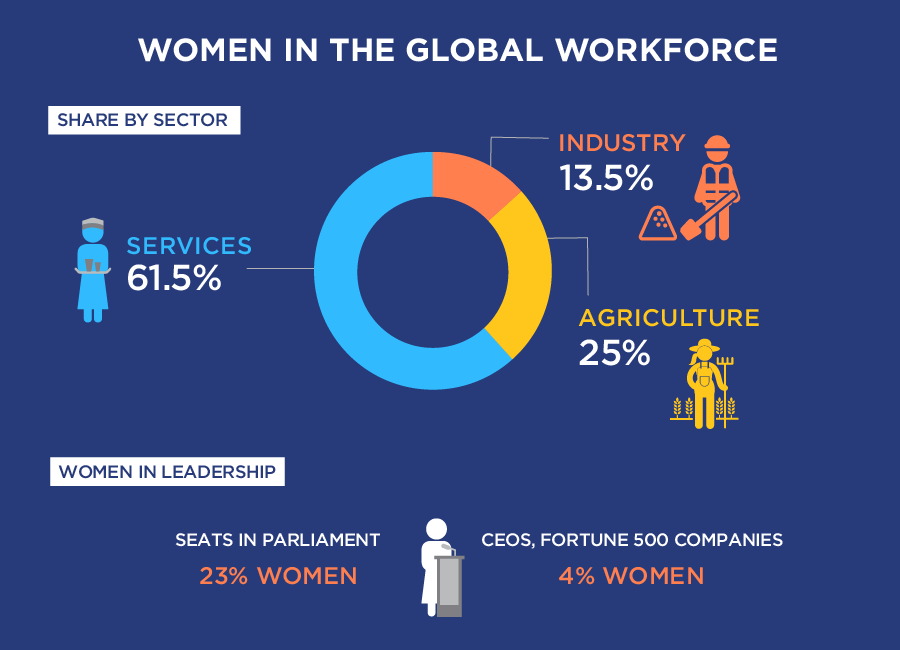
“You would think that I would deserve a fair promotion…want to move ahead but the boss won’t seem to let me…I swear sometimes that man is out to get me” (Dolly Parton). Women face many issues in the workplace including, but not limited to, equal pay, non-inclusion, biases, sexual harassment, and many do not have a woman as a role model within their organization. Throughout my first year as a college student, I encountered the majority of these issues all within one job, and although I discussed it in another diary, the situation has worsened to the point of resignation. In diary #2, I mentioned that I worked in a startup gym in Northeast Ohio that follows the typical gym stereotype. In my time there, women were childcare workers, smoothie bar baristas, and cleaners while the men were salesmen and personal trainers. While some may argue this is gender biased in both directions, the real issue is that men are given the better, higher paying jobs in comparison to the women with no indication that they do it better. Easily, this can be compared to Simone de Beauvoir’s concept of the One and the Other as discussed in The Second Sex. Women have always been viewed as the Other in society as men were clearly the One throughout history, but as women have taken on more roles, how should this power dynamic be changing?
Because this was my second diary of systemic injustice, there have been many case developments since my submission. After having multiple people quit or get fired, they proceeded to hire men back into membership or leadership roles and women back into service roles. As shown in the image below, this is not uncommon worldwide.

“The share of women in services reaches as high as 77 per cent and 91.4 per cent respectively in East Asia and Northern America” (UN Women). Even within the service industry, women are rarely given a fair chance to step into leadership roles. According to MSN, “A 2016 report from the Economic Policy Institute found that women have historically been steered into certain career paths (think: nurses, teachers, childcare workers), and that, in turn, can lead to different outcomes in pay and other factors” as seen in the featured image and the article linked below (“Most Common”).
After experiencing these unfortunate discrepancies first-hand with my previous employer, I better understood the fight for equality amongst genders in the workplace. As I ended diary 2, gender inequality and discrimination are real problems in the workplace and in society as a whole. Although this is a preconception dating back hundreds of years, society has been progressive, and you would think there would have been more done for equality by now. If a woman can perform equally or better than a man, who is to say she cannot or should not? Until society responsibly accepts and addresses gender biases in the workplace and uplifts capable women to positions of leadership, stereotypical dilemmas, like the one I faced, will continue to be prevalent in our lives.
Works Cited
Most Common Jobs Held by Women Today, www.msn.com/en-us/money/careersandeducation/most-common-jobs-held-by-women-today/ss-BB19pa2y.
Parton, Dolly. “9 to 5.” 9 to 5 And Odd Jobs, RCA Studios, 1980.
Report • By Jessica Schieder and Elise Gould • July 20. “‘Women’s Work’ and the Gender Pay Gap: How Discrimination, Societal Norms, and Other Forces Affect Women’s Occupational Choices-and Their Pay.” Economic Policy Institute, www.epi.org/publication/womens-work-and-the-gender-pay-gap-how-discrimination-societal-norms-and-other-forces-affect-womens-occupational-choices-and-their-pay/.
UN Women. https://interactive.unwomen.org/multimedia/infographic/changingworldofwork/en/index.html, 2017
I liked your use of charts to show the information better, this is ridiculous that women get paid less for doing the same amount and I really believe that your showcase highlighted the most important points,
After reading your response, I cannot believe the percentage at which women are affected by this inequality in the workplace. There is no reason that there should be a gender gap anywhere, considering that gender does not apply to the effort and quality of work that is displayed. All genders should be paid the same, and there should not be anyone getting paid less than deserved, just because of their gender, when they are doing equal or above the work of the other gender. I think your addition of the charts and percentages really helped show the extent to which this is happening.